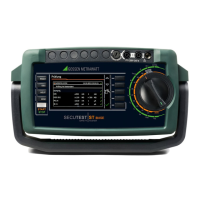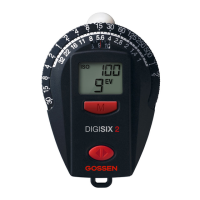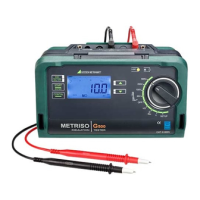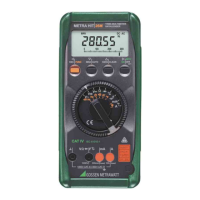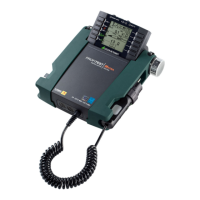GMC-I Messtechnik GmbH 23
6.5 Special Conditions
Protection Category II Devices with Protection Category I Mains Plugs
If the device under test is equipped with a protection cat-
egory I plug although it complies with protection category
II, protection category I is recognized by the test instru-
ment. If this is the case, switch the protection category
parameter from I to II.
Testing Several Protective Conductor Connections with the Func-
tion for “Automatic Detection of Measuring Point Changes”
During protective conductor measurement, the test instrument rec-
ognizes whether or not test probe P1 is in contact with the protective
conductor, which is indicated by means of two different acoustic sig-
nals. This function can be adjusted in the
SETUP
switch position in the
“
Auto Measurements”
submenu via the “
Auto Measuring Point
” parameter.
Protective Conductor and Insulation Resistance Measurements for
Permanently Installed Devices Under Test
Deactivate the electrical system which supplies power to
the device under test before connecting the test instru-
ment!
➭ Remove the mains fuses from the device under test and dis-
connect neutral conductor N inside the device under test.
Touch Current Measurement (absence of voltage)
Make sure that the contacted parts are not grounded.
6.6 2
nd
Test Probe (only SECUTEST PRO or feature H01)
If the device under test is not equipped with a country-specific
mains plug which fits into the test socket at the SECUTEST, or if a
permanently installed DUT is involved, the second test probe, in
combination with the first test probe, permits 2-pole measure-
ment (dual-lead-measurement) of RPE, RINS and equivalent leak-
age current.
Measurements with test probe 1 to test probe 2 (P1 – P2) are electri-
cally isolated from the mains. There’s no voltage at the test socket.
Please note that during insulation measurement the
maximum test voltage of 500 V may be applied between
the probes.
6.7 Connection Prompts
If a single measurement (green rotary switch positions) or a spe-
cific (integrated) automated test sequence (orange rotary switch
positions) is started, checking is conducted to determine whether
or not all of the probes and measurement cables required to this
end are connected (depending on the configuration level of your
SECUTEST...). If this is not the case, you’re prompted to connect
probes, measurement cables or the test adapter to the SECUT-
EST....
Checking is only conducted to determine whether or not the cor-
responding sockets are occupied – make sure that suitable
accessories have been connected for the selected measurement/
connection type. A list of possible DUT connections depending
on type of measurement is included in section 11.2.
6.8 Connection Tests Conducted by the Test Instrument
The following measurements are performed automatically when
the DUT is connected to the test instrument.
• Detection of Probes / Measurement Cables
During individual measurements / automated test sequences,
checking is conducted to determine whether or not the mea-
suring sockets required for the measurement/sequence are
occupied.
•
DUT connection detection
(only with country-specific variant *)
With the rotary switch in the AUTO/A1-A8 position, the “Test
Socket” connection type is selected automatically (if corre-
spondingly configured), if a mains plug is detected in the test
socket.
• Protection category detection
(only with country specific variant *):
With the rotary switch in the AUTO/A1-A8 position, protection
category I or II is selected automatically (if correspondingly
configured), depending on the detected type of mains plug.
• Short-circuit test
Before switching mains voltage to the device under test: test
for short-circuiting between L and N or L/N and PE. If applica-
ble additionally as “inspection test step” in automated test
sequences.
•
On test
(test whether the DUT is switched on or off)
Automatic Recognition of States
when Connecting DUTs and Probes
1
Applies to
M7050
with
feature B00 and B09
2
Applies as of version 1.7.0, previous condition: ≤ 1.5 Ω respectively > 1.5 Ω
3
50 V DC as of version 2.1.1
* Safety Shutdown
As of 10 mA of differential current (can also be set to
30 mA), automatic shutdown ensues within 500 ms. This
automatic shutdown does not take place during leakage
current measurement with clamp meter or adapter.
Control Function Condition
Short-circuit testL–N Short-circuit / DUT starting current R ≤ 2.5 Ω
2
No short-circuit (AC test) R > 2.5 Ω
2
Open-circuit voltage
U
0
4.3 V, short-circuit current I
K
< 250 mA
Short-circuit testLN–PE short-circuit R ≤ 2 kΩ
No short-circuit (AC test) R > 2 kΩ
Open-circuit voltage
U
0
230 V AC, short-circuit current I
K
< 1.5 mA
On test On (DUT passive) R < 250 kΩ
Off (DUT active) R > 300 kΩ
Open-circuit voltage
U
0
230 V AC, short-circuit current I
K
< 1.5 mA
Probe test No probe R > 2 MΩ
Probe detected R < 500 kΩ
Protection class detection
(only with country specific variant
1
)
Protective conductor found: PC I R < 1 Ω
No protective conductor: PC II R > 10 Ω
Safety shutdown
1
Triggered at following residual current value (selectable)
> 10 mA / > 30 mA
Triggered at following probe current values
During leakage current measurement > 10 mA
During protective conductor resistance measurement > 250 mA
Connection test (only with country specific variant
1
Checks whether the DUT is connected to the test socket.
DUT power cable found R < 1 Ω
No DUT power cable R > 10 Ω
Insulation test
DUT set up in a well-insulated fashion R ≥ 500 kΩ
DUT set up in a poorly insulated fashion R < 500 kΩ
PE mains – PE socket: Open-circuit voltage
U
0
500 V DC
3
, I
K
<
2mA
Overcurrent protection
Shutdown in the event of a continuous flow of current via the test socket at:
Our
SECUTEST BASE(10)
/
PRO
and
SECULIFE ST BASE(25)
test in-
struments permit active testing of devices with nominal current (load
current) of up to 16 A.
The test socket on the respective test instrument is equipped with 16 A
fuses to this end and the switching capacity of the internal relays is also
16 A. Starting current of up to 30 A is permissible.
In the case of test objects for which a starting current of greater than
30 A can be expected, we urgently recommend the use of a test
adapter for larger starting currents, for example test adapters from the
AT3 series.
I > 16.5 A

